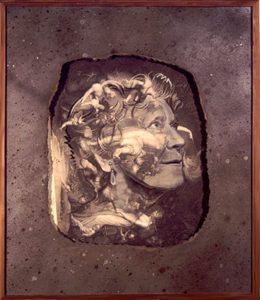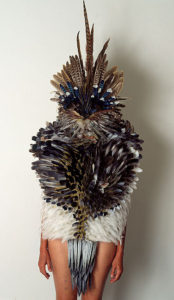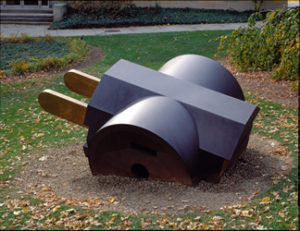Introduction
David Saunders. Ellen. 1991. Source Accessed 21 June 2016.
Saunders created a series of Shakespearean-inspired works; this piece evoked Midsummer Night’s Dream. Johnson writes about the portrait, “everything is marvelously interweaving like dreams, and like reality itself.” Additionally, see Document 4 for Saunders’ Swedish Angel, created for the cover of Johnson’s funeral program (Ellen Johnson, Fragments Recalled at Eighty: The Art Memoirs of Ellen H. Johnson (The Estate of Ellen H. Johnson, 1993), 154).
Tacha, Athena. Feather Armour for Ellen, 1992 Source
In her artist statement, Tacha writes, “In 1992, my two best friends died from cancer (one of them unexpectedly) and I confronted, for the first time so intensely and directly, suffering and death.” Tacha writes about the contradiction between feather and armor in New Fashions, “feathers not only protect the bird’s body from weather, but they embody signals about power and sexuality. However, unlike a mollusk’s shell, feathers are much too soft to protect the bird’s body from violence.” (Athena Tacha, “Artist’s Statement” in Vulnerability: New Fashions. http://oberlin.edu/faculty/atacha/tacha2.html; Athena Tacha, New Fashions (The Collier Printing Company: Wooster, Ohio, 1994), 15).
Document 2: Interview with Richard Spear
Oldenburg, Claes. Three Way Plug. Allen Memorial Art Museum. Accessed 1 May 2016. http://www.oberlin.edu/amam/Oldenburg_ThreeWayPlug.htm
Johnson commissioned Three Way Plug with Athena Tacha, then curator of modern art at Allen Memorial Art Museum (AMAM). It is situated on the lawn of AMAM. Johnson wrote in Modern Art and The Object, “Probably the most radical feature of the Giant 3-Way Plug (Cube Tap) is that it not only rejects but actually demolishes the base on which monuments traditionally stand, becoming instead a part of the earth, as its three-and-a-half ton weight thrusts into the ground like a boulder hurled from the sky.” Johnson articulates the sculpture’s contact with the earth with gender-specific implications: “The male dominance is further ensured by the fact that the female section is partially hidden (a womb within the womb of the earth). Had the Plug been placed otherwise, for example standing on its prongs like a building on stilts, as the English 3-way plug does, it would have had a totally different meaning.” He sought he physicalize a meaning of “plugging in” that went beyond the sexual, something which, Johnson noted, was apt for an academic setting of curiosity and research like Oberlin. Oldenberg sees Plug as a monument, fit for universities, because they “are for intellectual consumption.” Another work of his, Lipstick, on display at Yale University, critiques militarism, femininity, and masculinity during the Vietnam War. (Ellen H. Johnson, Modern Art and the Object (Westview Press: Boulder, Colorado, 1976), 157, 159-160).
Document 3: Letter from Deborah
Document 4: An Open Letter to Ellen


